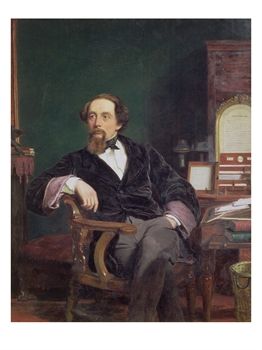However I did get today off and I decided - perhaps foolishly - that we should all go to London and see the William Powell Frith exhibition at the Guildhall. I should explain at this point that I wouldn't normally regard an art exhibition as a good day out for two small boys, but my wife is related to W.P. Frith and as this is the first time his paintings have been displayed together for 50 years, we had to go. I had no illusions about the day. I knew that my one-year-old would probably spend the entire journey screaming and that my seven-year-old would compare the paintings unfavourably to Pokemon, but not many people have a relative who was a best friend of Charles Dickens.
 I planned the journey like a military operation and even found myself using the 24-hour clock. It all started very well. There was no screaming, the trains ran on time and we managed to find a station near the Guildhall. In London I had plotted a route that would give us time to visit St Paul's Cathedral as I thought it would be good for my oldest son to see a really big building. Sadly, St Paul's was a huge disappointment, as it now costs £9.50 per person! We didn't go in.
I planned the journey like a military operation and even found myself using the 24-hour clock. It all started very well. There was no screaming, the trains ran on time and we managed to find a station near the Guildhall. In London I had plotted a route that would give us time to visit St Paul's Cathedral as I thought it would be good for my oldest son to see a really big building. Sadly, St Paul's was a huge disappointment, as it now costs £9.50 per person! We didn't go in.The exhibition was very good. W.P.Frith had no illusions about his status in the great scheme of things, writing that 'I am not a great artist, but I am a very successful one' and his paintings belong to the 'So good, it's almost like a photograph' school of art. In other words, art for Daily Mail readers.
Frith's success was phenomenal - when his painting of Ramsgate Sands was originally displayed, the galley's curators had to erect barriers to keep the crowds at bay - and his celebrity status during the Victorian age is probably one of the reasons why he has been neglected ever since. The famous paintings like Derby Day are displayed at the Tate, but many normlly lie in dark, unvisited vaults. This is a pity because although Frith's artistic merit may not be on a par with some of his contemporaries, anyone who wants to understand Victorian England must look at his paintings.

In its own way, Derby Day is a masterpiece because it encapsulates the different social stratas of Victorian society. It may not be great art, but it is good documentary. In the extreme left hand of the picture we can see a con artist trying to entice people to gamble. A local farmer in a rough smock starts to move forward whilst his wife pleads with him not to go. Next to the con artist, a folorn young man empties out his pockets after losing his money at the races. In the centre of the picture a man sits in a carriage serving champagne to three young women, who might be prostitues, whilst further right a bored-looking man leans against a carrige with his back to the unhappy woman who is probably his mistress. Rothko it ain't, but there should be room for W.P.Frith's work in our galleries.


1 comment:
Thanks for the interesting article on Frith. I noticed you mentioned that your wife is related to him
. . . so am i . . .
I would be intererested to know the connection.
cheers
Terazzo
Post a Comment